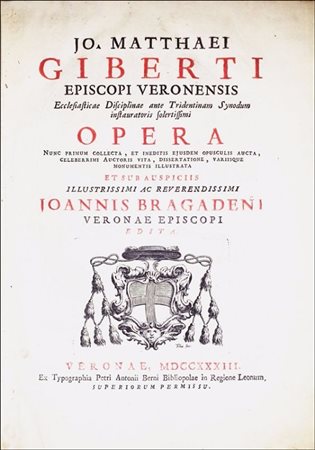 Bibliopathos - Via Enrico Toti 1, 37129 Verona
Bibliopathos - Via Enrico Toti 1, 37129 Verona
Medieval Notary Manuscripts & Law Books Sessione Unica - dal lotto 1 al lotto 280
Monday 28 December 2015 hours 17:00 (UTC +01:00)
FIRST EDITION OF GIBERTI'S COLLECTED WORKS, CONTAINING THE FAMOUS...
FIRST EDITION OF GIBERTI'S COLLECTED WORKS, CONTAINING THE FAMOUS CONSTITUTIONES GIBERTINAE
Giberti, Matteo.Opera nunc primum collecta, et ineditis ejusdem opusculis aucta ... auctoris vita, dissertatione, variisque monumentis illustrata [by Petrus and Hieronymus Ballerinius]. et sub auspiciis illustrissimi ac reverendissimi Joannis Bragadeni Veronae episcopi edita. Veronae: Ex typographia Petri Antonii Berni, 1733.
Small folio, 19th century half calf, pp. [16], civ, 356.
One engraved plate with the bishop Giberti at the beginning of the Constitutions.
The Appendix contains: P.F. Zini Boni pastoris exemplum, ac specimen singulare ex I.M.G. ... expressum, atque propositum; A. Castiglionei orationem funebrem Italicam de ipsius Giberti laudibus: A. Fumani alteram Latinam funebrem laudationem, etc.
Title vignette; head- and tail-pieces, initials.
Most text in Latin, with some in Italian.
First edition of Giberti's Collected Works, edited by the philologists Pietro and Girolamo Ballerini, also containing the Constitutiones Gibertinae, both in Latin and Italian version.
Gian Matteo Giberti (1495–1543) was an Italian diplomat, Bishop of Verona.
Giberti was chosen a member of the Consilium de Emendanda Ecclesia, the reform committee decreed by the Fifth Lateran Council, but political events soon put an end to these labours. At Pavia (1525) he tried to make peace between Francis I of France and Charles V. It was at his prompting that Clement VII espoused the cause of France; the League of Cognac (22 May 1526) was also his work.
After the Sack of Rome (1527) he was put in prison and barely escaped death. He succeeded in making his escape, and went to Verona (1528) intending to devote himself to his diocese. He was done with politics, all the more because the pope had gone over to the imperial cause. However, he appeared from time to time in the Curia. Pope Paul III recalled him to Rome for the work of the Reform Committee; among other missions he was sent to Trent to make preparations for the council.
His efforts to reform his diocese, whose clergy were in a deplorable state, were crowned with success. The Tridentine reforms were put in force long before the council assembled. St. Charles Borromeo, before taking charge of his see at Milan, wished to study Giberti's system at Verona, and chose as his vicar-general a priest from Verona trained in Giberti's school.
His first aim was to improve the standard of ecclesiastical knowledge. In his own palace he set up a printing-press which turned out numerous editions of the Greek Fathers, in whose writings he was very learned. He reformed the choir-school of Verona; for the instruction of the young he had printed the catechism known as Dialogus, the work of Tullio Crispoldi (1539).










